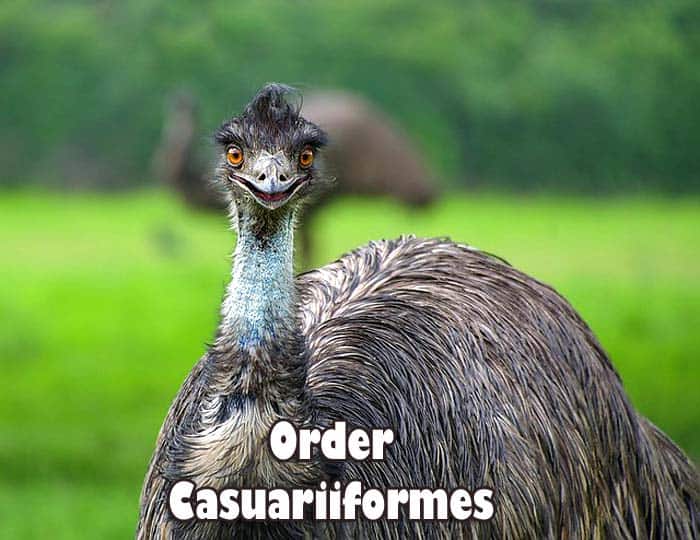
Order Casuariiformes includes two families of flightless terrestrial birds that are both native to Australia: emus and cassowaries. Previously, these birds were grouped with kiwis and ostriches, but now they are classified into a separate order due to several features unique to them.
Table of Contents
Casuariiformes Pronounciation
![]()
Casuariiformes Characteristics
Here are the characteristics of order Casuariiformes:
- These birds are large and heavy. For instance, the emu can be up to 1.8 meters in height and can weigh 55 kg.
- In emus and cassowaries, females are usually slightly larger than males;
- The plumage of Casuariformes is usually brown, while naked skin on head and neck can be colored blue (in emus) or orange/red (in cassowaries).
- All birds in the order have long, strong legs and equally long necks with relatively small heads.
- Casuariformes have hair-like feathers that lack secondary branches called barbules.
- These birds have no differentiated tails or tail feathers.
- Casuariformes have only three toes, the middle toe on both legs has an elongated and dagger-like claw.
- Several bones of the skeleton are reduced in all species in the order.
- They have no keel, as well as the wing bones. Only the collarbone remains, and the humerus is significantly shortened.
- Their wings are modified into 5 hollow spines.
- The birds in Casuariiformes order are monogamous.
- These birds build no nests, and the eggs are laid into depressions in the grass.
- In the pair, the female lays the eggs, and the male is responsible for their incubation, as well as care for the young hatchlings.
- The young birds reach maturity in about two years.
- Cassowaries prefer tropical rainforest and can be aggressive.
- Emus can live in different conditions, from forests to grasslands.
- These birds are herbivorous: cassowaries feed on fruit; emus can also eat seeds and grasses.
- Both cassowaries and emus used to be one of the primary sources of food for Aborigines of Australia and New Zealand.
- For the white settlers, emus are often considered as pests, as they can eat the crops.
![]()
Order Casuariiformes Species
There are few living species in the order:
- Cassowary, Casuarius casuarius.
- Casuarius unappendiculatus
- Casuarius benneti
- Emu, Dromaius novaehollandiae
There are also several extinct species:
- †Dromauis ocypus
- †Casuarius lydekkeri
- †Hypselornis sivalensis
- †Diogernonis fragilis
![]()
There are many birds in Casuariiformes are considered dangerous to humans especially Cassowaries. There were several reported attacks on humans.
![]()
Cite This Page
APA7MLA8Chicago
BioExplorer.net. (2025, May 28). Order Casuariiformes / Emus & Cassowaries. Bio Explorer. https://www.bioexplorer.net/order-casuariiformes/.
BioExplorer.net. "Order Casuariiformes / Emus & Cassowaries" Bio Explorer, 28 May 2025, https://www.bioexplorer.net/order-casuariiformes/.
BioExplorer.net. "Order Casuariiformes / Emus & Cassowaries" Bio Explorer, May 28 2025. https://www.bioexplorer.net/order-casuariiformes/.











